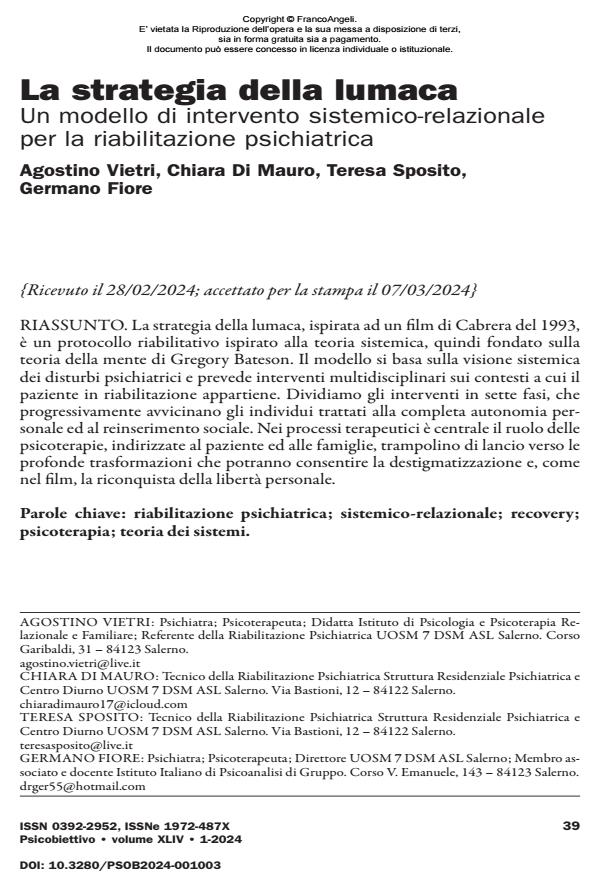The snail ’s strategy . A systemic-relational intervention model for psychiatric rehabilitation
Journal title PSICOBIETTIVO
Author/s Agostino Vietri, Chiara Di Mauro, Teresa Sposito, Germano Fiore
Publishing Year 2024 Issue 2024/1 Language Italian
Pages 15 P. 39-53 File size 155 KB
DOI 10.3280/PSOB2024-001003
DOI is like a bar code for intellectual property: to have more infomation
click here
Below, you can see the article first page
If you want to buy this article in PDF format, you can do it, following the instructions to buy download credits

FrancoAngeli is member of Publishers International Linking Association, Inc (PILA), a not-for-profit association which run the CrossRef service enabling links to and from online scholarly content.
The snail’s strategy, inspired by a 1993 film by Cabrera, is a rehabilitation protocol inspired by systemic theory, therefore founded on Gregory Bateson’s theory of mind. The model is based on the systemic vision of psychiatric disorders and provides multidisciplinary interventions on the contexts to which the rehabilitation patient belongs. We divide the interventions into seven phases, which progressively bring the treated individuals closer to complete personal autonomy and social reintegration. The role of Psychotherapies, aimed at the patients and families, is central in therapeutic processes, a springboard towards the profound transformations that will allow destigmatization and, therefore, the reconquest of personal freedom.
Keywords: psychiatric rehabilitation; systemic-relational; recovery; psychotherapy; systems theory
- Anthony W.A. (1993). Recovery from mental illness: The guiding vision of the mental health service system in the 1990s. Psychosocial Rehabilitation Journal, 16(4), 11-23.
- Bateson G. (1972). Verso un’ecologia della mente. Adelphi, Milano.
- Falloon I.R. (1985). Behavioural family therapy. In: Leff J., Vaughn C. (eds.). Expressed emotion in families: Its significance for mental illness. The Guilford Press, New York
- Heiddeger M. (1927). Essere e Tempo. Longanesi, Milano, ed. italiana 2005.
- Kuhn T.S. (1962). The structure of scientific revolutions. University of Chicago press, Chicago.
- Medina Centeno R. (2022). La terapia familiar de tercer orden. Del amor indignado al diálogo solidario. Morata, Madrid.
- Morin E. (2001). I sette saperi necessari all`educazione del futuro. Raffaello Cortina, Milano.
- Onnis L.(2004). Il Tempo Sospeso. FrancoAngeli, Milano.
- Prigogine I. (1991). La complessità. Esplorazioni nei nuovi campi delle scienze.
- Boringhieri, Torino.
- Semisa D., Bellomo A., Nigro P., Merlin S., Mucci A. (2022). Raccomandazioni di buone pratiche in riabilitazione psicosociale per adulti. Giovanni Fioriti, Roma.
- Von Bertalanffy L. (1968). General system theory. Foundations, development, applications. Penguin, London.
- Watzlawick P., Weakland J.H., Fisch R. (1974). Change. Astrolabio, Roma
Agostino Vietri, Chiara Di Mauro, Teresa Sposito, Germano Fiore, La strategia della lumaca Un modello di intervento sistemico-relazionale per la riabilitazione psichiatrica in "PSICOBIETTIVO" 1/2024, pp 39-53, DOI: 10.3280/PSOB2024-001003